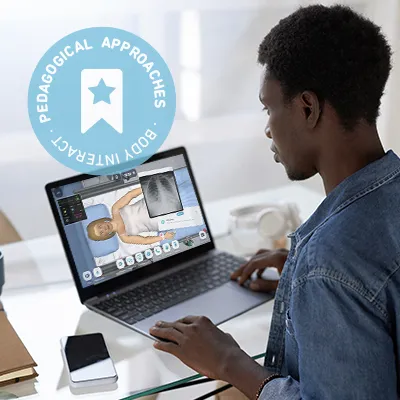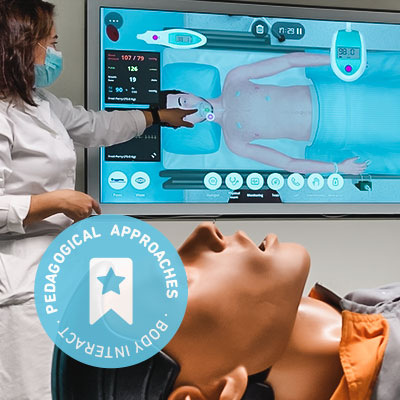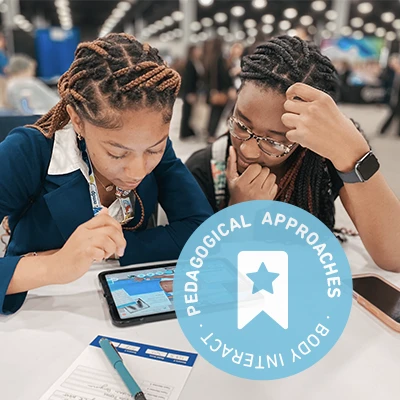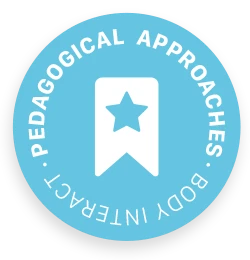
Pedagogical Approaches with Body Interact | Flipped Classroom
What is the Flipped Classroom?
The Flipped Classroom is an instructional strategy where traditional teaching methods are reallocated to a different phase of the teaching-learning process.
Instead of students learning new content during class time through lectures provided by the professor, they independently study the material outside of class, often through videos, listening to a talk or podcast, reading, completing exercises, and online modules. Then, face-to-face class time is utilized for engaging and active learning strategies aimed at cementing knowledge and connecting theory with practice. These strategies can include discussions, problem-solving, interactive exercises, group learning, case studies to application of concepts, facilitated by the professor.During class, the professor should collect data on students’ performance in order to propose strategies for optimizing student learning.
This approach completely breaks away from the traditional method of delivering medical curricula, where professors deliver lectures to an audience of passive learners, who would then study those subjects before exams.
How can it be applied with Body Interact?
Actually, Body Interact could be used for any of the three moments – before, during, and after class:
A scenario could be provided as an activity for students to engage with, complemented, for example, with scientific references, and recorded lectures on the subject.
A scenario may be used as the active learning strategy in small groups to foster discussion, the application of knowledge, and bridge theory with practice.
A scenario could be provided as an extended resource for students to solve after class, and for example, a comprehensive report regarding the scenario could be requested as an exercise.
However, we believe that it can be most effectively used as the active learning strategy employed during class.
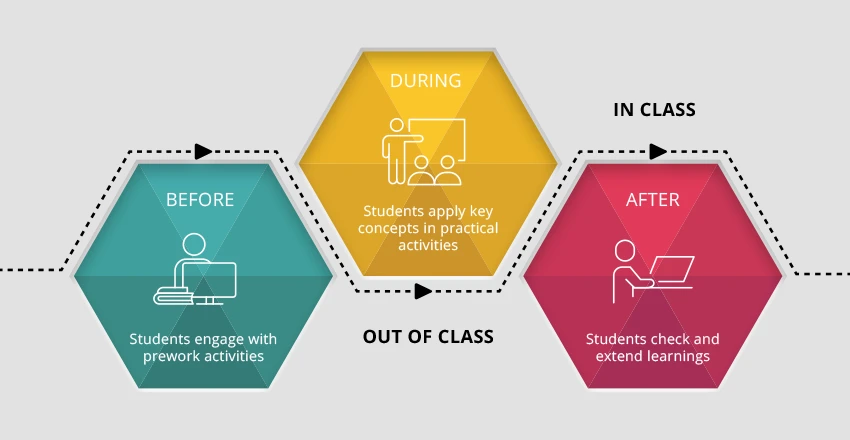
What are the benefits of using the Flipped Classroom and combining it with Body Interact Virtual Patients?
In a medical curriculum, implementing the flipped classroom strategy can offer several benefits for both the student and the professor.
Benefits of the Flipped Classroom for the Student
- Student-centered approach: Students shift from passive listeners to active learners.(2)
- Active learning: Flipped classrooms promote active learning by engaging students in discussions, problem-solving, and hands-on activities during class time.(2) This can enhance understanding and retention of complex medical concepts.
- Flexibility: Students have the flexibility to learn at their own pace outside of class, allowing them to review materials as needed, spend more time on difficult topics, and signalize any content not fully understood, providing a better management of the cognitive load of medical content.(1)
- Application of knowledge: Flipped Classroom provides greater opportunities for students to apply their knowledge.(2) Class time can be used for applying medical knowledge to clinical scenarios, simulations, or case studies. This helps students develop higher-order critical thinking and problem-solving skills essential for medical practice.
- Individualized instruction: In a flipped classroom, instructors can provide personalized feedback(2) and support to students based on their specific learning needs, fostering individual growth and a more supportive learning environment.
- Improved engagement: Flipped classrooms often incorporate discussions, multimedia resources, and interactive online platforms, which can increase student engagement and motivation to learn.(2)
- Time efficiency: By moving lectures and content delivery outside of class time, instructors can optimize class time for more meaningful interactions with students, maximizing the use of limited instructional time in a medical curriculum.
- Inclusive environment: By allowing students to engage ahead with theoretical knowledge, the overall group of students gets more at the same level.
- Preparation for lifelong learning: The independent learning skills developed in a flipped classroom model can better prepare medical students for lifelong learning and continuing education in their future medical careers.

Image courtesy of Brittany Maxwell.
Benefits of the Flipped Classroom for the Professor
- Transforms the role of the teacher from a disseminator of knowledge to a facilitator.
- Opportunity to provide theoretical content that students can engage with previously.
- Focus on providing active and practical activities in class.
- Provides an engaging learning environment and contextualized knowledge.
Undoubtedly, the Flipped Classroom presents benefits both for professors and students, but it also has implications. Students must actively engage with prework resources and the professor is required to do some front-end work – preparing engaging prework content, mastering the active learning strategies implemented in the class, and collecting formative data to monitor students’ progression and difficulties.
Flipped Classroom best practices suggestions
- Prework activities based on pre-recorded videos have proven to be quite useful in health professions education.(2) So, create/use short videos as an engaging activity before class.
- Be cautious not to overwhelm students with excessive prework, as it may lead to demotivation(1).
- Create a session in the BI Studio to prepare both before and after work, in this Flipped Classroom approach with Body Interact: Provide prework for students through the learning resources area and supply a wrap-up clinical scenario and any additional resources immediately after class.
- Quizzes at the beginning of face-to-face class further enhance the effectiveness of the Flipped Classroom.(1,2)
- Make optimal use of in-class time through problem and case-based activities, such as Body Interact Virtual Patients, applying the knowledge the student studied in prework contents.(1)
Who is using this instructional strategy?

Brittany Maxwell
Professor Brittany Maxwell, Assistant Professor of Nursing at St. Elizabeth School of Nursing, University of Saint Francis, in the United States is successfully employing this strategy with her nursing students, using Body Interact as the engaging and interactive learning strategy in class.
Want to know more about this pedagogical approach? Would you like to share your pedagogical approach with us? Schedule a meeting with us!
References
1- Phillips J, Wiesbauer F. The flipped classroom in medical education: A new standard in teaching. Trends in Anaesthesia & Critical Care 42:4–8 (2022) doi: 10.1016/j.tacc.2022.01.001. Epub 2022 Jan 13. PMCID: PMC9764229.
2- HEW, K.F., LO, C.K. Flipped classroom improves student learning in health professions education: a meta-analysis. BMC Med Educ 18, 38 (2018). https://doi.org/10.1186/s12909-018-1144-z


